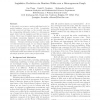Free Online Productivity Tools
i2Speak
i2Symbol
i2OCR
iTex2Img
iWeb2Print
iWeb2Shot
i2Type
iPdf2Split
iPdf2Merge
i2Bopomofo
i2Arabic
i2Style
i2Image
i2PDF
iLatex2Rtf
Sci2ools
SDM
2012
SIAM
2012
SIAM
Legislative Prediction via Random Walks over a Heterogeneous Graph
In this article, we propose a random walk-based model to predict legislators’ votes on a set of bills. In particular, we first convert roll call data, i.e. the recorded votes and the corresponding deliberative bodies, to a heterogeneous graph, where both the legislators and bills are treated as vertices. Three types of weighted edges are then computed accordingly, representing legislators’ social and political relations, bills’ semantic similarity, and legislator-bill vote relations. Through performing two-stage random walks over this heterogeneous graph, we can estimate legislative votes on past and future bills. We apply this proposed method on real legislative roll call data of the United States Congress and compare to state-of-the-art approaches. The experimental results demonstrate the superior performance and unique prediction power of the proposed model. 1 Background and Motivation Humanistic and social studies, including anthropology, criminology, marketing, sociology, ...
Data Mining | Parliamentary Governments | Political Science Studies | SDM 2012 | Semantic Similarity |
| Added | 29 Sep 2012 |
| Updated | 29 Sep 2012 |
| Type | Journal |
| Year | 2012 |
| Where | SDM |
| Authors | Jun Wang, Kush R. Varshney, Aleksandra Mojsilovic |
Comments (0)

